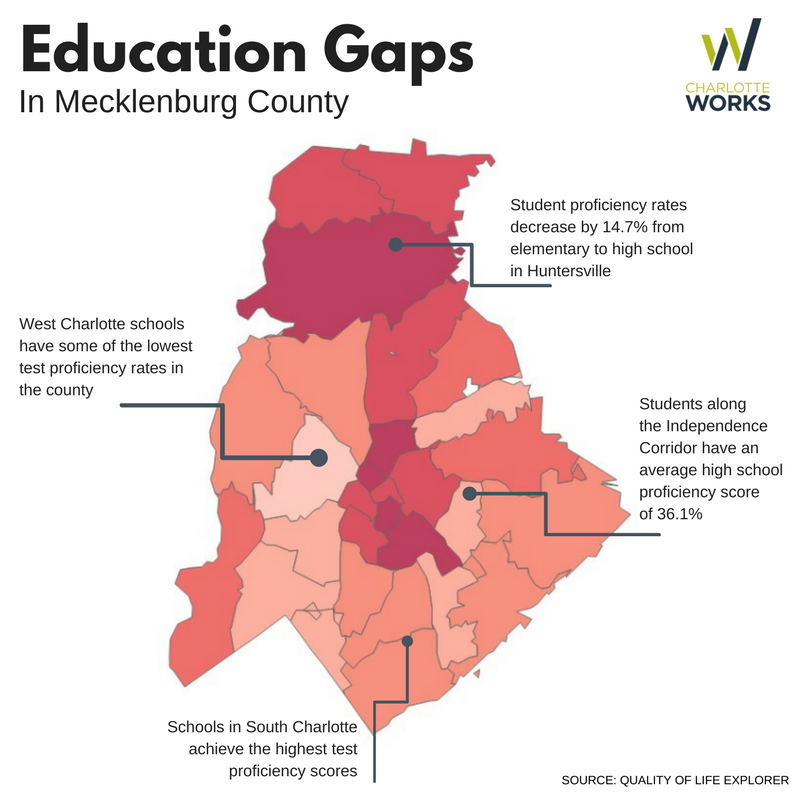
09 Feb Education gaps and their impact on Charlotte’s workforce
Education plays a powerful role in economic mobility. Studies show that a child’s zip code is more likely to determine his or her future success than other factors like cognitive ability. Local education initiatives have become a robust talking point for Charlotte leaders working to improve economic mobility. The Leading on Opportunity Task Force report identifies several strategies aimed at improving education and outcomes for the more than 150,000 students who depend on Charlotte-Mecklenburg Schools to deliver a quality education. Before we can implement these strategies, and as listed as the first strategy of the Leading on Opportunity report, we must first understand the complexities of educational outcomes in Mecklenburg County. Charlotte Works’ Community Poverty Indicators map provides a nuanced look at educational achievement from elementary to high school by zip code.
Acknowledging these areas of improvement has tremendous impacts for Charlotte’s workforce. As companies seek to expand or relocate to Charlotte, they’ll be looking for a highly educated talent pool, starting at an early age. Industry leaders expect that students are obtaining the reading comprehension, mathematical and technological skills that will help their company grow. Postsecondary institutions are seeking the brightest students to accept into their programs; Charlotte area students may get bypassed for students who come from areas with better education systems.
Charlotte Works’ Education Gaps map shows the percent decrease, by zip code, in student test proficiency levels from elementary school to high school. Darker shades indicate rate declines from elementary to high school. The areas where the drop is sharpest include Huntersville (28078 zip code), NoDa (28206), Uptown (28202), Myers Park (28207) and Costwold (28211). At its largest gap, students living in the Cotswold area can expect their test scores to drop by more than 13 percent from elementary school to high school.
Lighter shades of red represent zip codes where proficiency levels increase from elementary to high school. However, it’s important to note that many of these areas have very low proficiency rates overall. Test scores are especially low in West Charlotte (28208, 28214 and 28216) with the highest high school proficiency rate topping out at 38 percent. This pattern is mirrored in East Charlotte.
Overall, this map serves to underscore some of the gaps in quality education for Mecklenburg County. Only four zip codes in the county house schools with high school proficiency levels above 65 percent; only two zip codes reach 80 percent or above. All four are located in south Charlotte. Students living in “the crescent” (geographic area spanning from west Charlotte through east Charlotte) consistently score low on the standardized reading and math tests, leaving them less educated than their neighbors. Students living in traditionally wealthier areas also face barriers to quality education as they reach high school and their test scores drop, leaving them underprepared for postsecondary education or the workforce.
Charlotte Works is helping address these gaps by partnering with MeckEd to assist students in four low-performing schools in getting access to work-based learning opportunities and career pathway development. These schools include Garinger High School, Harding University High School, Independence High School and Zebulon B. Vance High School. While our efforts help around 90 students each school year, it’ll take a community-wide effort to improve outcomes for Charlotte’s students and future workforce.



